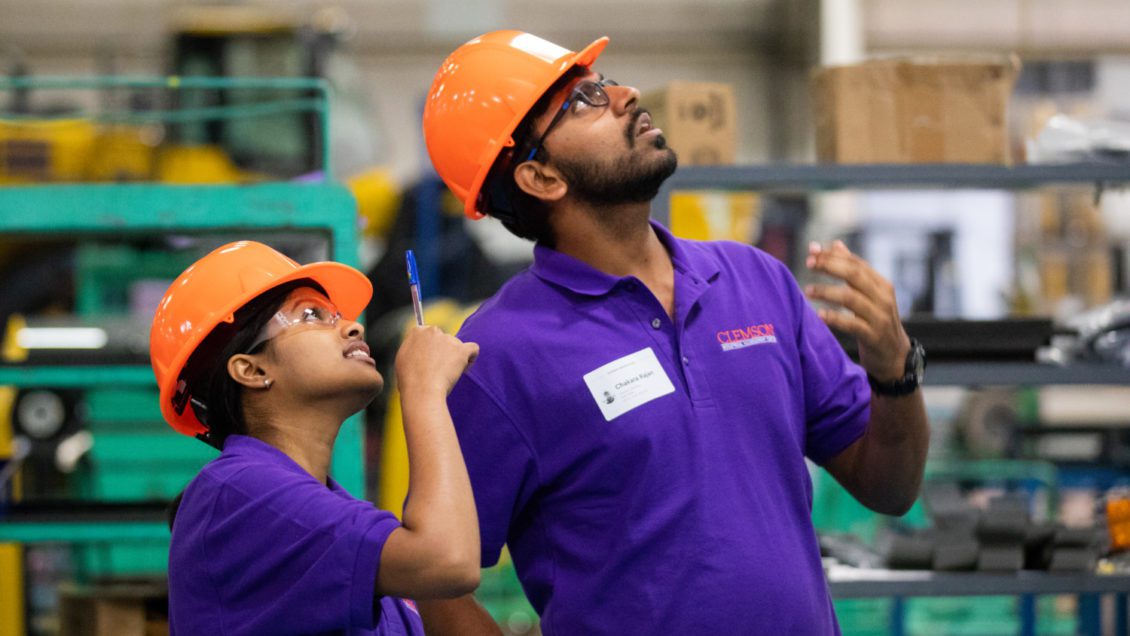The whirring of pneumatic wrenches filled the Komatsu plant in Newberry, South Carolina as four Clemson University students made their way past workers assembling yellow forklifts.
A woman noticed the students’ bright orange hard hats and greeted them with the two words every Clemson diehard likes to hear.
“Go Tigers!” she yelled.

It was a warm welcome for a team that had made the 90-minute drive from campus to help Komatsu assess how it could reduce its energy use.
The students were from Clemson’s Industrial Assessment Center, a program that takes engineering education out of the classroom and into manufacturing plants.
The center’s energy-use assessments are free and come with the potential to save each participating company tens of thousands of dollars.
With 17 site visits in its portfolio, the center charged into its third year with a total of 11 students eager to leave their mark on the world.
Among them is Lakshana Nagaraj, who is working toward a master’s degree in industrial engineering.
“I think energy saving is the ‘in’ thing right now,” she said. “There is a lot happening with climate change and the environmental effects. We need to do something about it. This is the first step. Everyone can make an effort toward energy saving.”
The center’s teams have been fanning out across the state for two years to assess small- to medium-sized manufacturers. They have recommended ways to save an estimated $1.6 million in energy, with each company saving an average of more than $25,000 per year.
The assessments have also helped companies reduce their environmental impact, while giving students real-world experience and connecting them with employers, said Michael Carbajales-Dale, the center’s director and an assistant professor of environmental engineering and earth sciences.
“The way some of these companies talk with students– it’s almost like an interview,” Carbajales-Dale said. “They see students as potential new employees. A lot of companies realize the good training that IAC students get.”
Clemson launched the center in October 2016 after receiving nearly $1.3 million from the U.S. Department of Energy’s Office of Energy Efficiency and Renewable Energy.
It is among 28 Industrial Assessments Centers nationwide that provide no-cost assessments to small- and medium-sized companies. In an October 2018 report, the White House cited the centers as an example of a federal program that “contributed to the progress in manufacturing education, training and workforce development.”

To be eligible for an assessment, companies must have fewer than 500 employees at the plant site, gross annual sales below $100 million and have annual energy bills between $100,000 and $2.5 million.
The plant must be within 150 miles of an Industrial Assessment Center. Most of the Clemson assessments take place in South Carolina, although the center’s coverage area also includes parts of Georgia, North Carolina, Tennessee and southwestern Virginia.
Clemson’s center is made up mostly of undergraduate engineering students who work up to 14 hours a week as paid interns for as many semesters as they are available.
Students work under the supervision of faculty members, including Carbajales-Dale. Phil Litherland, the assistant director of the center, helps lay the groundwork prior to site visits.
On the Komatsu site visit, the team looked for ways to save money throughout the plant from the cranes and compressed air system to the lighting and heating.
Ben Snelson, an industrial engineering major, said that when he first started doing assessments he hardly knew what a manufacturing plant looked like. By the time he went to Komatsu, he had been on several site visits and had an eye for energy efficiency.
It was good that many of the workers were using cordless drills powered by batteries and saving the compressed-air drills for the bigger jobs, he said.
“When you have a ton of running tools and a lot of lines and a lot of moving things, the hoses can get leaks really easily,” Snelson said. “They’re using batteries, so it’s cheaper. Compressed air is expensive.”
All signs point to a bright future for the center. Carbajales-Dale said he was working to find new sites to assess and for new ways of connecting clients with various pools of money, such as low-interest loans and rebates, that may be available to help make energy-efficiency upgrades.
“It’s not just in-and-out,” he said, “but we’re connecting them with resources that can help get the job done.”
For more on the center, go to: https://cecas.clemson.edu/iac/
Get in touch and we will connect you with the author or another expert.
Or email us at news@clemson.edu

